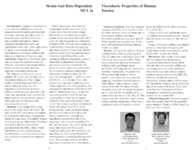| OCR Text |
Show Making Sense of Smell in Moth Brains Olfaction begins with the transduction of chemical information of odor molecules into electrical signals by olfactory neurons. In the moth, these neurons are present within cuticlar hairs lining the antenna and send their axons into the primary central processing area for olfactory information- the antennal lobe (AL). There axons terminate and make synaptic contacts with central neurons within spheroidal knots of neuropil known as glomeruli. The glomerular architecture is a common feature of the primary processing area across highly divergent animal taxa. By using moths as a simple model system, we seek to understand how the three dimensional organization of the AL neuropil contributes to the ability to discriminate and recognize different odors and odor blends. Antennal lobes of adult males and females of Heliothis virescens, Heliothis subflexa, and Helicoverpa zea were reconstructed three dimensionally in order to further our understanding of the architecture of the olfactory neuropil. Males possess a sexually dimorphic subset of enlarged glomeruli, known as the macroglomerular complex (MGC) associated with olfactory processing of female sex pheromone information. The other glomeruli in the antennal lobe are referred to as "ordinary" glomeruli. These glomeruli are thought to process general odorant information such as plant and floral volatiles. By using three dimensional reconstructions as maps, the male and female ALs of these species were compared in order to investigate the extent of sexual dimorphism of the primary olfactory center. H.virescens males have 66 glomeruli (4 MGC) compared to 63-64 in females. H. subflexa males have 66-67 glomeruli (4 MGC) compared to 63 in females. H.zea males have 66 glomeruli (3 MGC) whereas females have 64 glomeruli. The male MGC is clearly dimorphic in each species, but nearly all female glomeruli have homologous male counterparts. The female AL includes one or two glomeruli near the antennal nerve which may not have male counter parts. In addition, inter specific comparisons reveal that all three species have a similar number and arrangement of ordinary glomeruli. Future experiments will attempt to determine the role of any dimorphic female glomeruli and whether structurally similar ordinary glomeruli have divergent olfactory functions, both within and across species.(Supported by USDA, NRI, CGP 1999-03451 to NJ Vickers.) David A. Kelly Class Standing: Junior Major: Biology E-mail: poreden@hotmail.com Neil Vickers Department of Biology E-mail: vickers@biology.utah.edu |









































